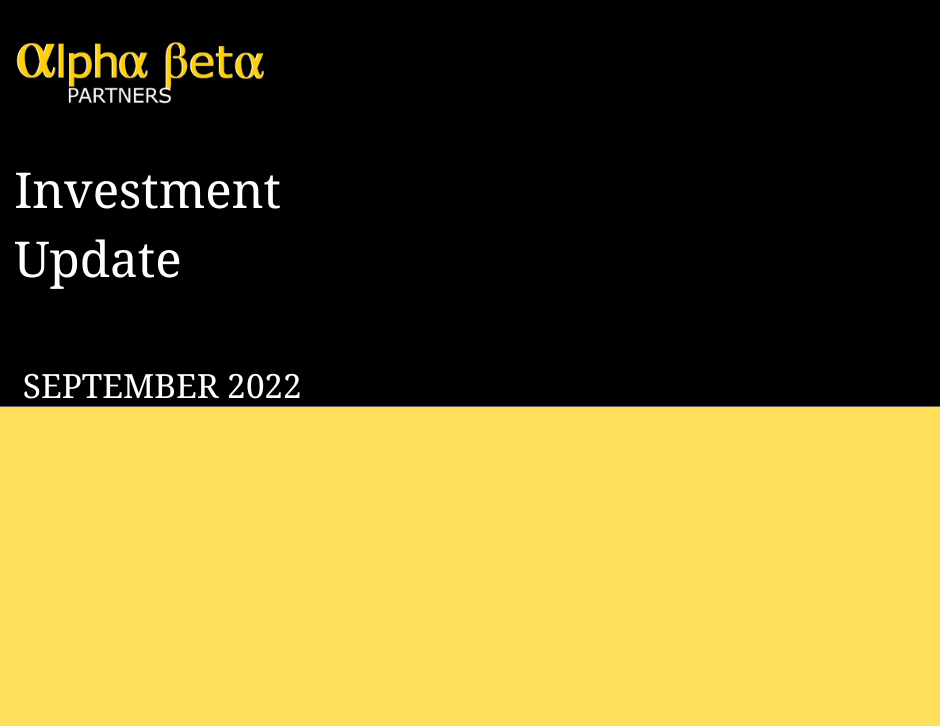Investment Update October 2022
- ABP Team

- Oct 3, 2022
- 4 min read
Updated: Aug 29, 2023
This is the first time since data was recorded (1976) that we have seen 3 consecutive quarters of simultaneous declines in the S&P 500 and Bloomberg Aggregate Bond index. All major asset classes have shown to be correlated during this unprecedented period as inflation and its consequences coupled with geopolitical risks have ravaged markets. Higher cash weightings and healthy exposure to US dollar assets have provided a powerful antidote to the worst that markets have thrown at us during the period. Alpha Beta portfolios are down, of course, but relative to industry benchmarks and the market itself, we are in reasonable shape.
Central banks around the world raised rates in line with expectation during September, although the Bank of England’s monetary response was a little more restrained. The monetary tightening phase in the US looks set to peak during the first quarter next year, stabilising thereafter before beginning to nudge lower. Other developed markets are likely to synchronise, as ever, with some variation dependent upon local drivers. The table below from FedWatch considers the latest data and jinto a forward view based on probabilities for US rates – shown here peaking at around 4.5% - 4.75% towards the latter stages of the first quarter 2023. Things change as data is refreshed but the near-term future trajectory is upwards.

Source: CME Group FedWatch
As at 2 October 2022
Central banks remain squarely focused on their mandate for controlling price stability (inflation) and employment. Impacts on stock and bond markets are very much a secondary consideration to “slaying the inflation dragon”. Eradicating inflation is anything but easy, especially with geopolitical issues remaining unresolved. Key inflationary drivers – food and energy prices are presently beyond the control of central banks.
A tough month in the US and elsewhere with the S&P 500 losing c9% of its value.US GDP was revised into barely positive territory of +0.1% for the last quarter measured, but sufficient for the world’s biggest economy to say, “no recession here”, yet. Valuations have come way down and if one removes the major blue chip technology giants such as Apple, Microsoft, etc then things look altogether better value. That said, US equities remain considerably more expensive than other global markets. The US dollar, the defacto global reserve currency, has seen a tremendous inflow of assets boosting its value hugely relative to other major currencies. This will help downward pressure on inflation, although non-domestic earnings from larger US companies will be sharply and negatively impacted. The Federal Reserve actions are provoking signs of strain in the residential housing market which has boomed in recent times. Mortgage costs have leapt to 6%+ quickly. The market is slowing, and sale prices are beginning to soften. Very much in line with central bank policy, albeit bringing pain to ordinary folks. The approaching US mid-term elections will offer an interesting political backdrop, and historically have a net positive impact on markets.

Source: Trading View
As at September 2022
At home, the new Prime Minister enjoyed a baptism of fire following sweeping fiscal changes announced in the Mini Budget. An old-fashioned run on the pound ensued and gilt yields spiked sharply higher bringing solvency concerns to pension schemes and other asset pools. Gilt holdings in lower-risk portfolios across the industry were adversely impacted. That said, equity valuations in UK have fallen to levels which are attracting attention from investors with an eye for a bargain.
Europe remains firmly in the grip of the energy crisis with some industries and larger operators such as Volkswagen beginning to consider more radical options of switching production to areas less acutely affected. After nearly a decade and a half of an EU-appointed Technocrat government in Italy, we saw the first democratically elected administration in a little over 14 years. Markets remain challenging to recommend here. Japan’s sterling efforts to maintain low-interest rates continue to look risky but are broadly working, albeit at the expense of the yen and with inflation rising at a current high of 3%. The soaring price of the dollar is adversely impacting Emerging Markets who must pay a higher price for its dollar-denominated debt. China remains subdued with the onset of a recession and a property debt crisis. Western nations have begun to re-shore or near-shore some manufacturing away from China. This will damage China’s growth although much of the world’s supply of rare earths, critical in the development of green projects, is controlled there.
A tough month at portfolio level, albeit performance has been buoyed by the well-timed decision to raise cash earlier in the month and by the herculean efforts of our dollar holdings. In the expectation of US markets possibly testing 3300 on the S&P 500, therefore meeting a more logical re-entry valuation point, we have begun to consider our strategy for revisiting risk assets. The VIX term structure – a forward-looking measure of volatility is beginning to fall, modestly and still with the ability to revert negatively, but an encouraging sign all the same. The time will come when our good friend the US dollar begins to fade, and equity values Stateside begin to rise once more – this will happen before rates pivot lower in our view. Identifying suitable investments which allow for price participation without currency erosion is underway. Likewise, a closer examination of domestic UK equities at striking valuations has some appeal. Similarly, a further rotation of the fixed income holdings towards a longer duration is scheduled for the right moment when portfolios can enjoy the pick-up from lower interest rates further ahead.
So, a tough time endured by investors recently whose resilience will be well rewarded. From this point, there is more upside than downside for long-term investors. We are already forming our strategies and have more than adequate “dry powder” to deploy when the time comes.




